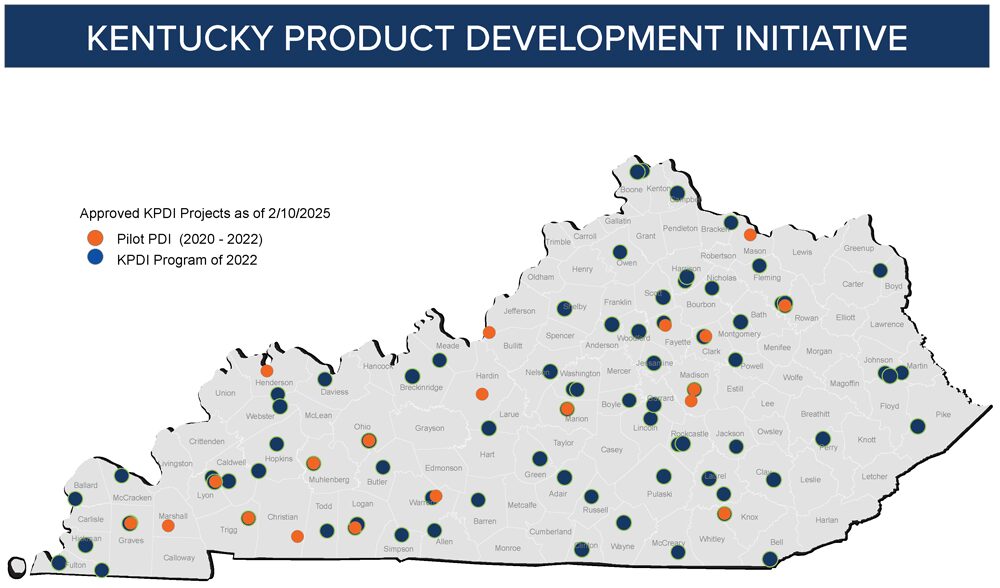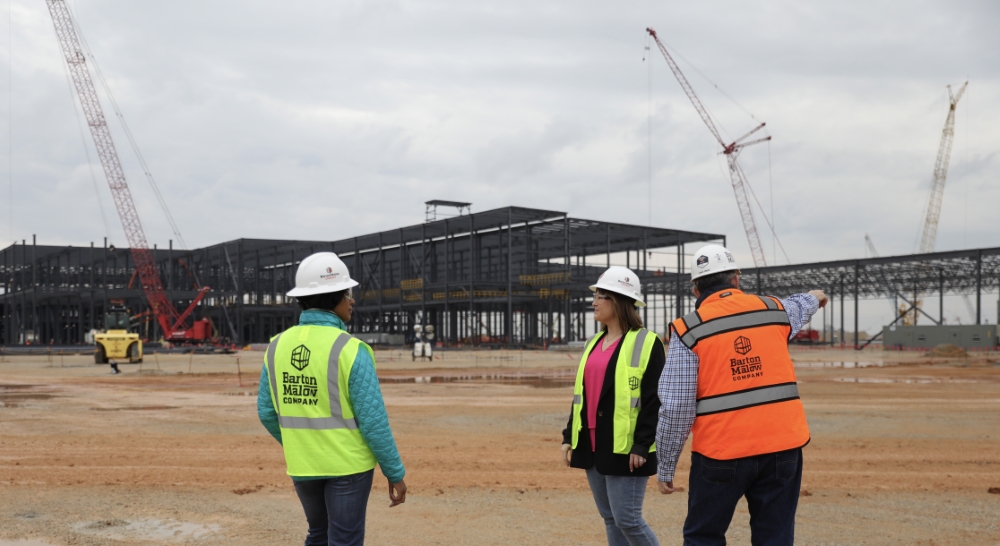State funding closes gaps in making business sites shovel ready.
Kentucky’s ability to land corporate facility investment projects increased exponentially with the launch six years ago of the Kentucky Product Development Initiative.
A state-funded program that provides matching grants to localities for the development of shovel-ready sites, KPDI has proven to be a game-changer for communities across the Bluegrass State. Projects like Pratt Industries in Henderson and Phillips Tank & Structure in Columbia may not have occurred without the dollars from Frankfort to these communities for investment into creating development-ready sites.
The structure for administering the program is outlined on the KPDI website: “The established Kentucky Product Development Initiative (KPDI) 2024 Program is a statewide effort to support upgrades at industrial sites throughout the commonwealth and position Kentucky for continued economic growth. KPDI, a collaboration between the Kentucky Cabinet for Economic Development (KCED) and Kentucky Association for Economic Development (KAED), includes $35 million per fiscal year in state funding toward upgrades of sites and buildings across the state. KPDI applicants, such as local governments and economic development organizations, may seek funding assistance for transformative site and infrastructure improvement projects that will generate increased economic development opportunities and job creation for Kentucky residents. Through KPDI, funding is available through a competitive application process, with each of the 120 Kentucky counties eligible for a maximum funding amount calculated based on population. There is a maximum of $2 million per county per project. Applicants are encouraged to submit regional projects, which allow available funding for multiple counties to be combined, increasing the maximum allowed for a given project.”
Since its inception in 2019, the commonwealth has set aside $170 million for site development — money that has been used to help communities land record-setting amounts of corporate facility investments across the state’s 120 counties.
Jeff Noel, secretary of the Kentucky Cabinet for Economic Development, calls KPDI a game-changer for economic development.
“Go back to the pilots that were done. We had $100 million in the first round and $70 million in the current round,” he said. “Pratt Industries invested $500 million into a KPDI site in Henderson. Companies all over the state have located on KPDI sites. To award these funds, we use an outside consultant who goes into communities and evaluates each proposal. They ask questions like ‘Do you have the right tools for your workforce? What is the land you are proposing?’ We use that to score the applications for funding. We then provide feedback to each community. Our communities are stronger because of these KPDI programs.”
How KPDI Works at the Local Level
Missy Vanderpool, executive director of Henderson Economic Development, said that KPDI was instrumental in her community landing the $500 million plant investment by Pratt Industries. She added that KPDI funds are also being used to develop the Sandy Watkins Site in Henderson’s 4 Star Industrial Park.
“This site is just over 100 acres and is a CSX Railroad site with water, gas and electrical power,” she said. “We were able to use state funds to create a Build-Ready Pad of just over 1 million square feet. That is now the largest pad in the state.”
Jenny Schenkenfelder, senior sites and buildings manager and GIS specialist for KCED, said “there is a whole KPDI site selection and vetting process. A third-party, non-biased entity chooses the projects that receive funding. We keep track of the sites and buildings that get awarded funding. We are now in the third round of funding. Project managers are finishing their site visits now.”
In the current round of KPDI, some 32 sites are being evaluated, noted Schenkenfelder.
“Properties that just need that next step of development qualify for these funds,” she said. “This benefits many smaller and rural communities that otherwise would not have the money to do this on their own.”
A matching amount of dollars is required from each community that wins a KPDI grant. Smaller communities may qualify for relief from the 1-to-1 matching requirement and may have to contribute only 10% to 20% of the amount.
“Using those funds for infrastructure and roads can help a community solve the need for speed to market,” says Schenkenfelder.
Round one of KDI concluded in December 2023 and resulted in 53 projects statewide being approved for $31.2 million in funding. Those dollars were combined with local contributions that led to more than $123 million in new investments made to sites and buildings in Kentucky’s portfolio.
To date, round 2 of KPDI has seen over $51 million in state funding go to 36 approved projects across Kentucky. Combined with local contributions, these projects generated more than $380 million in investment in buildings and sites.

KCED also oversees the Build-Ready program for the state.
“We approve all of the Build-Ready pad sites,” said Schenkenfelder. “We work with the local economic developer in concert with an engineering firm. They have a checklist of actions that they must send over to us. We have as many as 26 Build-Ready pads across the state. Several of those sites have been created with the use of KPDI funds.”

“Companies all over the state have located on KPDI sites. To award these funds, we use an outside consultant who goes into these communities and evaluates each proposal.”
– Jeff Noel, Secretary, Kentucky Cabinet for Economic Development
Case in point is the Green River Commerce Park in Columbia in Adair County.
“We were fortunate to be included in round one and round two of KPDI,” said Heather Spoon, consultant for the Economic Development Authority of Columbia-Adair County. “KPDI enabled us to double our dollars at Green River Commerce Park. We spent $459,000 on that site and the state matched it. That put almost a million dollars into GRCP. Our new Build-Ready pad is ready to go, and we have won three very impactful projects.”
Two of those wins are Phillips Tank and Pennyroyal Distillery. Because of state assistance through KPDI, Spoon said “we are even more ready now to host companies for a visit.”
Meanwhile, Kentucky continues to invest dollars in its Build-Ready Program. This initiative helps communities get shovel-ready sites developed quickly. These state resources can be used to help local jurisdictions assemble controllable sites for development; complete archeological, environmental and geotechnical studies; construct a building pad; perform preliminary design work; and approve site plan permits.
The commonwealth is home to 26 available Build-Ready sites. Multiple other locations across the state are currently working toward certification.

To date, 12 former Build-Ready-certified sites — including tracts located in Barren, Butler, Christian, Graves, Hart, Laurel and Pulaski counties and five sites in Warren County — have been selected by companies for new location projects. These sites allow companies to bring their operations online in a cost-efficient manner while creating jobs for Kentuckians.
From Gas Pump to Closed Deal
All that preparation paid off when representatives of Martins Peterbilt came calling.
“They were literally driving through our county and stopped at a corner gas station and asked if anyone knew of a commercial building site for sale,” said Spoon. “I set up a tour of 14 sites in Adair County within an hour. I got to know who they were, and they ended up picking a facility with a business in it. I made a connection, and they ended up striking a deal.”
Martins Peterbilt sells Peterbilt trucks and parts and services those vehicles too. Today, Adair County has another contributing business because the community took the steps needed to be ready for new industry.
“We live in a microwave world, not a crockpot world,” said Spoon. “In this culture, people don’t wait for a callback. Sometimes, rural economic development starts at the local gas station — and when a prospective buyer is in town and ready to make a deal, you must be ready to assist them. That’s exactly what we did in Adair County.”
Today, that business employs 17 workers making an average annual wage of $72,000.
“We landed a $2 million annual payroll because we were ready,” said Spoon.
Around the 120 counties of Kentucky, other places are taking notes and following suit.
To learn more about available sites in Kentucky, visit SelectKentucky.com.

